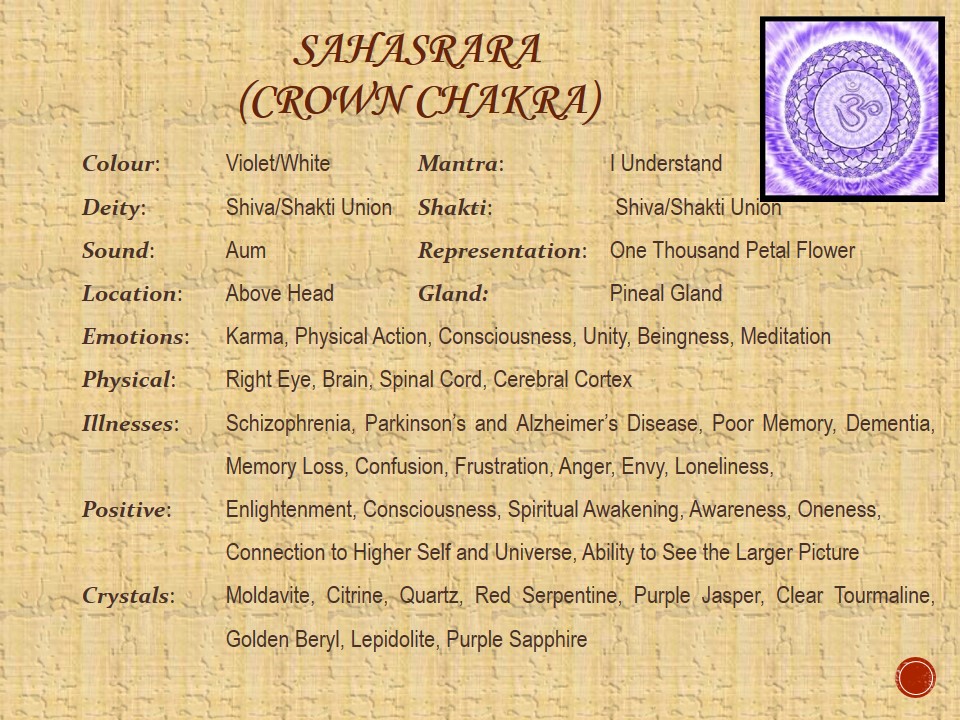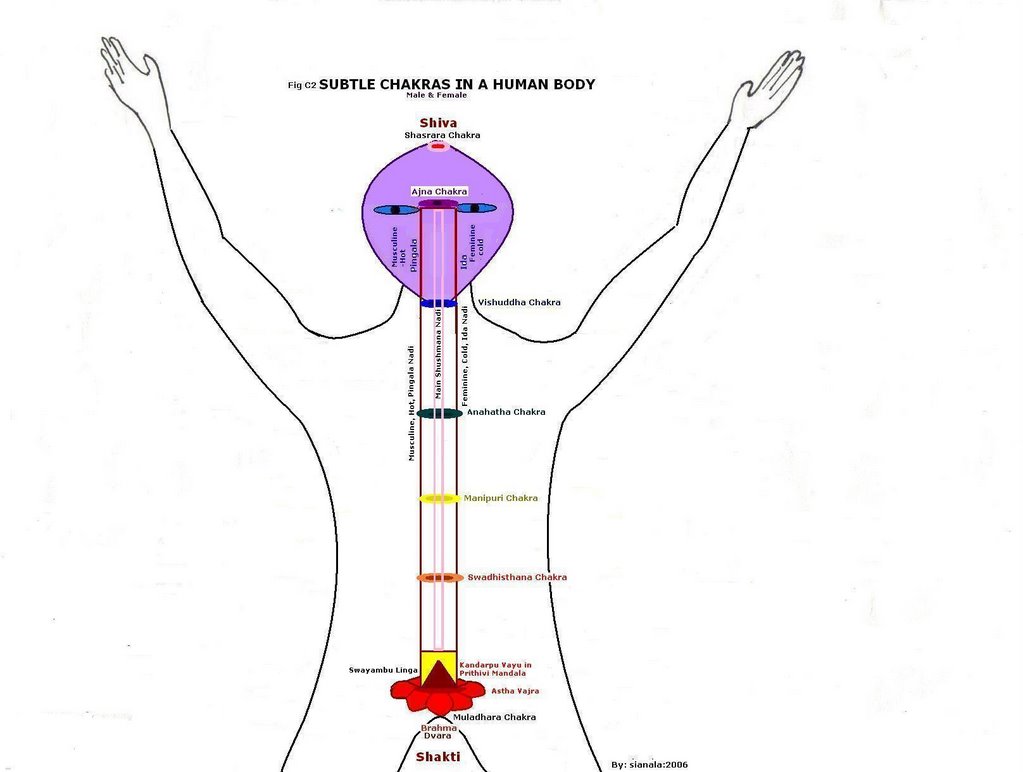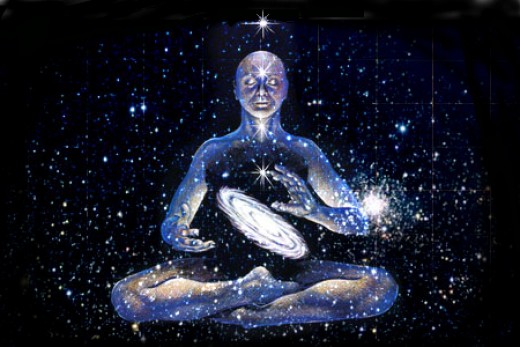

 Sahasrara (Sanskrit: सहस्रार, IAST: Sahasrāra, English: "thousand-petaled") or crown chakra is generally considered the seventh primary chakra, according to most tantric yoga traditions.
Sahasrara (Sanskrit: सहस्रार, IAST: Sahasrāra, English: "thousand-petaled") or crown chakra is generally considered the seventh primary chakra, according to most tantric yoga traditions.
Description

Image of a Sahasrara Chakra with 1000 petals, in 20 layers of 50 petals each.
Appearance
The Sahasrara is described as a lotus flower with 1,000 petals of different colors. These petals are arranged in 20 layers, each layer with approximately 50 petals. The
pericarp is golden and within it a circular moon region is inscribed with a luminous triangle, which can be either upward- or downward-pointing.
[1]
Function
Often referred to as a
thousand-petaled lotus, it is said to be the most subtle chakra in the system, relating to pure consciousness, and it is from this chakra that all the other chakras emanate. When a yogi is able to raise his/her
kundalini, energy of consciousness, up to this point, the state of
Nirvikalpa Samādhi is experienced.
This stage is said to bring about rebirth or the
siddhis - occult powers of transforming into the divine, and being able to do whatever one wishes.
Associated chakras
In some schemes of chakras, there are actually several chakras, which are all closely related, at the top of the head. Rising from
Ajna,
[2] we have the
Manas chakra on the forehead,
[3] which is closely associated with Ajna. Above Manas there are
Bindu Visarga at the back of the head; Mahanada; Nirvana, which is located on the crown;
[4] Guru;
[5] and the Sahasrara proper, located above the crown.
[1]
Bindu Visarga

Bindu visarga is also connected with
ajna.
The Bindu Visarga is located at the back of the head, in a place where many
Brahmins keep a tuft of hair. It is symbolized by a crescent moon on a moonlit night, with a point or bindu above it. This is the white bindu, with which
yogis try to unite the red bindu below. It is said to be the point through which the soul enters the body, creating the chakras as it descends and terminating in the coiled
kundalini energy at the base of the spine. It is often described as the source of the divine nectar, or
amrita, though this is sometimes said to come from either ajña chakra or lalita chakra. This nectar falls down into the digestive fire (
samana) where it is burnt up. The preservation of this nectar is known as "urdhva retas" (literally: upward semen). The white drop is associated with the essence of semen, while the red bindu is associated with menstrual fluid.
This chakra is sometimes known as the Indu, Chandra, or Soma Chakra. In other descriptions, it is located on the forehead - white, with 16 petals - corresponding to the
vrittis of mercy, gentleness, patience, non-attachment, control, excellent-qualities, joyous mood, deep spiritual love, humility, reflection, restfulness, seriousness, effort, controlled emotion, magnanimity and concentration.
Mahanada
The name of this chakra means "Great Sound", and it is in the shape of a plough. It represents the primal sound from which emanates all of creation.
Nirvana
This chakra is located on the crown of the head. It is white in color and possesses 100 white petals. It marks the end of the
sushumna central channel. It is responsible for different levels of concentration:
dharana,
dhyana and
savikalpa samadhi.
[4]
Guru
The Guru Chakra is located above the head, just below Sahasrara proper. It is white, with 12 white petals, upon which is written
guru. It contains a circular moon region, within which is a downward pointing triangle containing a jeweled altar, with the crescent moon below and circular bindu above. Inside the bindu is the seat, near which are the gurus footstools, upon which are the gurus feet.
[5] This position is considered very important in
Tibetan tantric practice of
deity yoga, where the guru or deity is often visualized as above the crown, bestowing blessings below (for example in the
Vajrasattva purification meditation).
Higher levels
Within Sahasrara, there are yet more levels of organization.
[6] Within the triangle begins a series of ever higher levels of consciousness: Ama-Kala, the First Ring of Visarga, Nirvana-Kala, and Nirvana Shakti, which contains the Second Ring of Visarga. From here,
Kundalini becomes Shankhini, with 3-and-a-half coils. The First Coil of Shankhini wraps around the Supreme Bindu, the Second Coil of Shankhini wraps around the Supreme Nada, the Third Coil of Shankhini wraps around Shakti, and the Half-Coil of Shankhini enters into Sakala Shiva, beyond which is Parama Shiva.
[1]
Ama-Kala
Visarga
Visarga is symbolized by two small rings, one of which is inside Ama-Kala, and the other of which is below Supreme Bindu, which represents the transition from samprajnata samadhi to the oneness of asamprajnata samadhi.
Nirvana-Kala
Here Kundalini absorbs even the experience of samadhi, through the power of supreme control (Nirodhika-Fire).
Nirvana-Shakti to Parama Shiva
Here Kundalini passes into the supreme void, which is the experience of asamprajnata or
nirvikalpa samadhi, and becomes Shankhini. Shankhini wraps around and absorbs the Supreme Bindu, which is the void; then the Supreme Nada; then Shakti; and then unites with and absorbs Sakala Shiva; before finally being absorbed into Parama Shiva, which is the final stage of
nirvikalpa samadhi.
Association with the body
Comparisons with other systems
The crown wheel is important within the
Anuttarayoga Tantra tradition of
Buddhist Vajrayana. It is triangular, with 32 petals or channels that point downwards, and within it resides the white drop or white
bodhicitta. Through meditation, the yogi attempts to unite this drop with the red bodhicitta in the navel, and to experience the union of emptiness and bliss.
[7] It is very important in the Tantric practice of
Phowa, or consciousness transference. At the time of death, a yogi can direct his consciousness up the central channel and out of this wheel in order to be reborn in a Pure Land, where he can carry on his tantric practices, or transfer that consciousness into another body or a corpse, in order to extend life.
In the West, it has been noted by many (such as Charles Ponce in his book
Kabbalah.) that Sahasrara expresses a similar archetypal idea to that of
Kether, in the
Kabbalistic Tree of Life, which rests at the head of the tree, and represents pure consciousness and union with God.
Within the Sufi system of
Lataif-e-sitta there is a Lataif called
Akhfa, the "most arcane subtlety", which is located on the crown. It is the point of unity where beatific visions of
Allah are directly revealed.
Alternative names
- In Tantra: Adhomukha Mahapadma, Amlana Padma, Dashashatadala Padma, Pankaja, Sahasrabja, Sahasrachchada Panikaja, Sahasradala, Sahasradala Adhomukha Padma, Sahasradala Padma, Sahasrapatra, Sahasrara, Sahasrara Ambuja, Sahasrara Mahapadma, Sahasrara Padma, Sahasrara Saroruha, Shiras Padma, Shuddha Padma, Wyoma, Wyomambhoja
- In the Vedas and late Upanishads: Akasha Chakra, Kapalasamputa, Sahasradala, Sahasrara, Sahasrara Kamala (Pankaja or Padma), Sthana, Wyoma, Wyomambuja
- In the Puranas: Parama, Sahasradala, Sahasraparna Padma, Sahasrapatra, Sahasrara, Sahasrara Kamala (Parikaja or Padma), Shantyatita, Shantyatita Pada
- In the Agni Yoga teaching, the Brahmarandhra is often referred to as "the bell" (Russian: колокол).[8]
See also































